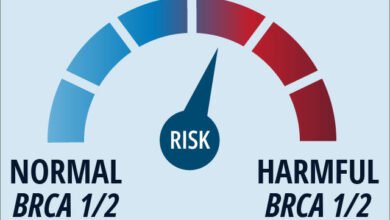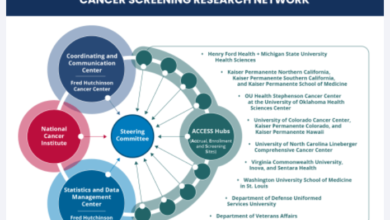Cancer Research UK – Science blog

Andrea’s treatment had to change because of chemotherapy-induced neuropathy.
A few summers ago, Andrea lost a flip-flop.
Anyone can misplace a shoe. But this was the only thing between Andrea’s foot and the London pavement. She didn’t notice that it was gone.
She began dropping things then, too.
“I couldn’t feel the pressure that I was applying when I was holding drinks. Quite often, they would just slip through my hands.”
As they smashed and shattered on the floor, glasses didn’t feel like the only things Andrea was struggling to keep hold of.
She was a young mother with bowel cancer, grappling with her mortality while trying to do her daughter’s hair. And these symptoms weren’t caused by the disease. The thing taking her body away from her was the treatment.
“When you’re going through a cancer diagnosis, trying to be strong for your children and trying not to worry your family, just something as simple as breaking a glass, for the third time in a week, becomes so overwhelming,” Andrea says.
“I would very often just burst into tears. And someone looking in would probably think, ‘Why’s she overreacting?’ But it’s because it’s just another thing – and it has nothing to do with the cancer. What’s trying to save my life is causing me its own set of problems. It’s making my life worse.”
What was happening?
The problem Andrea was – and, to some extent, still is – dealing with is a type of nerve damage called chemotherapy-induced peripheral neuropathy (CIPN, or neuropathy from chemo).
The symptoms of neuropathy can range from mild pins and needles to losing all feeling and control of your hands and feet. It can be caused by cancer treatment, but doctors don’t have a way to treat it.
We’re helping some of the world’s best scientists change that.
Why might chemotherapy cause pins and needles?
Chemotherapies are especially good at killing cancer cells, but they can also harm healthy ones. These include the peripheral nerve cells that carry messages back and forth between the brain and spinal cord (the central nervous system) and the rest of the body. When peripheral nerve cells are damaged, it becomes harder for the messages to get through.

A damaged peripheral nerve cell (foreground) compared to a healthy one. Blue Ring Media/Shutterstock.com
That’s a big problem when messages have to travel a long way, like to the hands or lower legs.
Andrea’s peripheral neuropathy started as pins and needles on the soles of her feet. Then the feeling moved up to her hands.
“You know if you sleep on your arm and it goes a bit tingly? I thought that’s what had happened. But it progressively got worse until it was really overwhelming. It’s not something you can ignore. When I’m sleeping, when I’m walking, when I’m sitting down – constant pins and needles.”
Then, despite the hot summer, Andrea’s feet became freezing cold. Eventually, she began to lose all sense of them at all.
It’s hard to walk when you don’t know where your feet are, so Andrea had to drive everywhere. That’s not much easier. If they weren’t strapped into heavy winter boots, the things on the end of her legs wouldn’t stay on the pedals.
After her eighth cycle of chemotherapy, Andrea’s doctors had to stop giving her the platinum-based drug oxaliplatin. Although it was helping to shrink Andrea’s cancer, oxaliplatin is one of the drugs most likely to cause peripheral neuropathy. It was putting her at risk of permanent, life-altering nerve damage, so her last four cycles of treatment couldn’t include it.
Why is chemotherapy-induced peripheral neuropathy such a problem?
Andrea is now cancer-free.
In some cases, though, when side-effects stop cancer treatment, they shorten people’s lives.

Alison Lloyd, whose work is funded by us and the Medical Research Council.
As Professor Alison Lloyd, from University College London, makes clear, “Neuropathy is one of the major limiting factors for chemotherapy.” That’s because, once a chemotherapy drug starts causing neuropathy, the only way doctors can stop it getting worse is by taking the drug away.
The problem is made worse by the fact we can’t even test people to see who’s at risk of developing neuropathy from chemo. All doctors and patients can do is wait to see if symptoms will appear. Uncertainty like that can make treatment decisions much more difficult.
“We don’t have an identifiable biomarker, or sign in the body to predict which patients will suffer this toxicity and how severe it will get,” says Professor Lillian Siu, who’s been treating head and neck cancers, often with drugs that can cause neuropathy, for 25 years. “I can’t give more information than ‘You have to take it and see what happens’. And that’s not necessarily attractive to anybody.”
To make things better, we need to find out more about how chemotherapy drugs affect nerve cells. That’s Lloyd’s specialism. Her investigations have brought an almost unknown system in our bodies into the spotlight. They could give doctors a way to predict, treat and even prevent neuropathy from chemo.
The blood, the brain and the nerves
We already knew a lot about how the nerve cells in the brain and spinal cord interact with chemotherapies. Or, more commonly, how they don’t. A special protective system called the blood-brain barrier (BBB) stops most drugs getting to them. That makes brain tumours hard to treat, but it can protect the brain and central nervous system from toxic side effects.
Neurotoxicities like brain fog or ‘chemo brain’, which Andrea has also experienced, are very difficult problems, but they’d be much worse without the BBB.
Things are a little different in the rest of the body. Exactly how different has long been a mystery. A lot of scientists know a lot of things about the BBB. Lloyd is the rare one who has found something out about its not-so-distant cousin: the blood-nerve barrier.
That works similarly to the BBB, stopping substances in the blood getting to sensitive peripheral nerves – it just gets nowhere near as much attention.
“When we first went to the blood-brain barrier meetings and said, ‘We’re trying to understand the blood-nerve barrier,’ the response was mostly, ‘There’s a blood-nerve barrier?’” recalls Lloyd.
What have we found out about chemotherapy-induced peripheral neuropathy?
The main difference, as Lloyd got used to explaining, is that the blood-nerve barrier is a little less secure. This might help explain how chemotherapy drugs can get through and cause peripheral neuropathy.
And it might also make the blood-nerve barrier a promising area to study. While everyone else was looking the other way, Lloyd’s team made a breakthrough. They found a way of opening and closing the blood-nerve barrier, simply by activating a signal in one of the types of cells that support it.
No one’s ever managed to do something similar in the brain.
“There was always this idea that you had to break down these barriers,” explains Lloyd. “But that would be toxic. We’ve shown you that can help things cross it, just for a short time, which makes side effects less likely.”

It’s very different when the blood-nerve barrier is open, as Lloyd’s team have shown.

Drugs (red spots) don’t get into peripheral nerves when the blood-nerve barrier is closed.
One the one side, opening the blood-nerve barrier is an important step towards delivering new types of cancer drugs to cancers that start in or spread through the nervous system. Then, quite apart from cancer, it could help treat nerve cell disorders and brain conditions like Huntington’s disease. It could even be the foundation for opening the blood-brain barrier and improving how we treat brain tumours.
At the same time, understanding how to strengthen or close the blood-nerve barrier could help us stop chemotherapy-induced peripheral neuropathy.
How doctors deal with peripheral neuropathy
Siu knows just how important that could be. Because there aren’t any tests for peripheral neuropathy today, all doctors like her can do is help patients talk about their symptoms.
“You can monitor other issues with scans and blood tests, but you can’t guess what’s happening to the nerve cells in every patient,” explains Siu. “You have to rely on them to tell you how they feel.
“We bring it up every visit. And I try not to wait till the symptoms become obvious, because sometimes there’s a delayed effect. If you wait till you have moderate toxicity to do something, it could be severe by the next treatment cycle.”

Professor Lillian Siu has been a senior medical oncologist at the Princess Margaret Cancer Centre in Toronto, Canada since 1998.
That discussion goes deeper than symptoms, though. Siu has learned that ‘who’ is just as important as ‘what’, ‘where’ and ‘when’.
Our hands and feet can root us in the world and connect us to each other. Some people will choose to continue treatment when their symptoms become severe, but others couldn’t imagine life with long-term peripheral neuropathy.
“I’ve treated a concert pianist, and they’re exquisitely sensitive about their finger movements,” says Siu. “With someone like that, we may mutually decide not to give a life-saving treatment and use an alternative, or to stop an effective drug early, because it could affect the most important part of their bodies.
“Sometimes you know the best drug to give, but you can’t give it, or you have to stop, because you’ve decided together that it’s too risky.
“It’s always such a tough decision. You can have a patient who’s experiencing a treatment response, which seems to be deepened with every cycle, and then all of a sudden you have no choice but to stop. You don’t want to make the wrong decision that will change the longevity of the patient. But, at the same time, I have to tell them that the neuropathy is only going to get worse if I continue.
“We can’t reverse time. The only thing we can do is let time heal. It does get better somewhat. But it’s not fast. And it’s not complete.”
The toxicities challenge
As well as being a senior oncologist, clinical trial director and professor of medicine in Toronto, Canada, Siu is also one of the newest members of the Cancer Grand Challenges Scientific Committee.
Cancer Grand Challenges, the global funding initiative we co-founded with the US National Cancer Institute in 2020, brings together research teams from around the world to take on the biggest problems in cancer research. Chemotherapy-induced neurotoxicities and neuropathies was one of the 9 new challenges announced in March this year.

Platinum chemotherapy drugs like cisplatin can cause peripheral neuropathy. NCI
Teams with the vision and expertise to uncover more about the processes behind issues like chemotherapy-induced peripheral neuropathy – and, ultimately, to help us understand how to prevent and treat it – have until 22 June 2023 to apply for funding of up to £20m ($25m).
“We have such great knowledge of so many things, and peripheral neuropathy doesn’t seem to be insurmountable,” says Siu. “It’s fitting that it’s a Cancer Grand Challenge, because it can be so difficult for patients, and we have the knowledge in this century to overcome it. If it wasn’t already time, it’s time now.
“We may not have leveraged enough knowledge from biologists like Alison. We don’t talk about the blood-nerve barrier very much. There are probably insights there that we haven’t taken advantage of.”
Better treatments without compromises
Those insights are piling up. In their latest scientific paper, Lloyd’s team covered the ground of decades of studies into the BBB.
“We’ve defined the structure and control of the blood-nerve barrier – all the cell types that are involved, how they interact, how it can be regulated and why it’s a barrier. It took more than 10 years of development, but we’ve got a model that enables you to see how a barrier can be opened and closed.”
From here, scientists can tackle some of the most debilitating side-effects of cancer treatment, making chemotherapy a better option for everyone. We’re ready with the funding they need to make a difference – and the knowledge of why it’s so important.

Andrea with her children
“You have this kind of love-hate relationship with chemo,” says Andrea. “You acknowledge that it could save your life, but at the same time it can cause you its own set of problems. I understand and respect that that’s why some people don’t want it – they’d much rather protect their quality of life.”
We’re with Andrea, and everyone else like her, whatever treatment decision they make. Our job is helping tip the balance. Beating cancer means making sure as many people as possible can get the best quality treatment while living their lives the way they choose.
“If chemotherapy didn’t have these side effects, it would be welcomed by so many more people,” says Andrea. And the more people we can treat, the more time we can give.
Tim
Source link
#Cancer #Research #Science #blog



